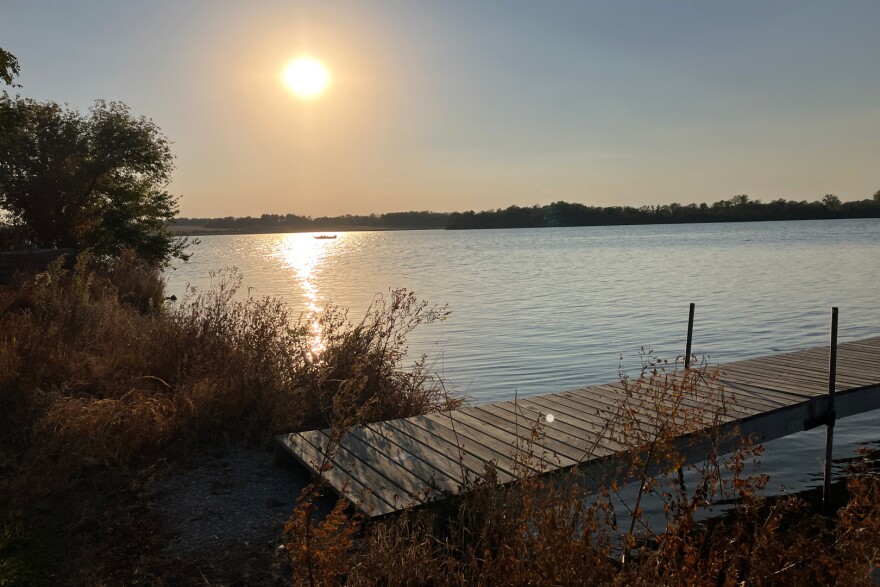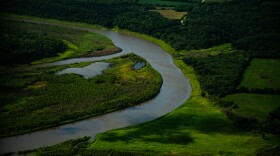During a heat wave in early October, a dozen adults and kids spread out across Big Creek State Park beach in Polk County.
Rena Wilson was reading a book in a lawn chair as her hair dried from a swim. She said this was her first time at Big Creek, but the Norwalk resident is a regular at other lakes around central Iowa.
“I love it. I’ll swim as long as it’s warm, anything above 85 degrees,” she said. “You feel close to nature out there with the birds and the water and the wind and the sun.”
Wilson said she checks the Iowa Department of Natural Resources’ beach monitoring dashboard before she swims in the summer.
From the week prior to Memorial Day through Labor Day, DNR crews collect water samples to monitor levels of E. coli and microcystin, a toxin produced by certain blue-green algae.
The DNR lists the weekly results online, along with data from the U.S. Army Corps of Engineers and dozens of cities and counties. If E.coli and microcystin levels exceed certain thresholds, the DNR issues beach advisories.
This year, the DNR issued 156 “swimming not recommended” advisories for state beaches, including Big Creek. All but five of the advisories were related to high E. coli levels.

E. coli is a large family of bacteria. Most strains are harmless and live in the intestines of warm-blooded animals, including humans. But some cause stomach cramps, diarrhea and vomiting if people swallow them.
For decades, high concentrations of E. coli in fresh water have been used as an indicator of possible fecal contamination and pathogens, which include disease-causing bacteria, viruses and protozoans.
“As the numbers go up, the risk of getting a gastrointestinal-type illness at the beach goes up. So, it's all about risk,” said Dan Kendall, an environmental specialist with the Iowa DNR.
Part of Kendall’s work is managing the state’s beach monitoring program, which began in 2000. He said 2025 marks the highest “straight count” for state beach advisories due to E. coli, but emphasized the number of beaches sampled has fluctuated over time.
The 2010 season had the highest “percent advisories,” followed closely by 2025, according to Kendall.
Digging deeper into E. coli at Iowa beaches
This long-term monitoring data also shows some state beaches frequently have high E. coli levels. This includes Backbone Lake, Big Creek Lake, Black Hawk Lake, Brushy Creek Lake, Springbrook Lake and Storm Lake.
“Knowing that we have these E. coli bacteria warnings that go out pretty regularly at certain beaches across the state, we really needed to dig a little bit deeper into what's going on,” said Jason Palmer, a natural resource biologist with the DNR.

Over a decade ago, Palmer and other DNR staff collected samples in and around Big Creek Lake, including inlets, open water, the recreational swimming zone and beach.
“We were noticing during that sampling that we were getting really high concentrations at the beach, but we weren't seeing really any E. coli anywhere else in the lake,” Palmer said.
When they expanded their sampling to a dozen other lakes around the state, Palmer said they found the same trend. E. coli levels were higher in swimming zones than deeper areas in the lakes. But concentrations were highest at the beach — specifically within 5 - 6 feet from the water’s edge.
The DNR’s findings emerged alongside a growing body of research showing some strains of E. coli can persist outside an animal’s gut and even grow under the right conditions. This includes a moist structure to grow on, nitrogen and carbon, and a stable temperature with protection from direct sunlight.
Wet sand, especially a few inches below the surface, can tick those boxes, Palmer explained.
Reducing runoff immediately around beaches could minimize the amount of E. coli deposited along the shoreline and help sand dry out faster, making it harder for bacteria to survive, he said.

DNR pilot project to reduce E. coli launches soon
The DNR is moving forward with a pilot project at two state beaches to understand what practices are most effective at reducing E. coli levels and help guide future management at other state beaches.
“Our first goal is to keep it from running onto the sand, and the second goal is to treat it before it enters the lake at a different point,” Palmer said.
This includes bioswales to capture runoff from parking lots, according to Michelle Balmer, the DNR’s lake restoration program coordinator. She said the depressions hold water, allowing it to slowly filter through plant roots, soil and gravel. Native plants also provide habitat for pollinators and other wildlife, Balmer added.
Other design elements include rain barrels next to buildings and tiles and culverts around beaches to help eliminate runoff.
Balmer said the DNR’s goal is to begin construction at Brushy Creek State Recreation Area in Webster County later this fall or winter during a campground renovation. Work at Big Creek State Park would likely begin after Labor Day next year.
Working to pinpoint fecal sources, pathogens and risk
Beyond these efforts to understand the relationship between beaches and E. coli and reduce their concentrations, the DNR is trying to learn more about high bacterial levels and risk.
Claire Hruby, assistant professor of environmental science and sustainability at Drake University in Des Moines, worked with Palmer while she was at the DNR.
In 2016 and 2017, they sent water samples to the U.S. Geological Survey (USGS) Laboratory for Infectious Disease and the Environment in Wisconsin to screen for the genetic material of viruses. Some of the samples had high E. coli levels but no viruses. Others had viruses but low levels or no E. coli.

Their findings led to a DNR project that began in 2023 to screen both sand and water samples for specific pathogens, identify potential sources of fecal contamination and better understand the health risks for recreationists.
To compare results across different lake systems, they selected state beaches at Big Creek Lake, Lake Macbride, Clear Lake and Backbone Lake.
Macbride, located in eastern Iowa, and Big Creek represent two highly popular recreation areas, Palmer said. Clear Lake is a glacial lake in northern Iowa, while Backbone is a dammed lake in the northeastern part of the state. It functions like a river, with heavy rain flushing sediment and other material into the lake system, Palmer said.
“Backbone does show up as having high E. coli more frequently throughout the sampling season, across time,” he added.
Just after sunrise at Big Creek beach, Kaitlyn Mathews, a seasonal environmental field technician with the DNR, kneeled at the water’s edge to pound a 4 inch tube into the sand. Then she scooped it out and handed it to Palmer to snap a cap on.

Next to them, a machine pumped lake water through a series of medical-grade filters. The DNR ships the filters on ice, along with several sand samples from each beach, to the USGS Laboratory for Infectious Disease and the Environment. There, they’ll be screened for certain pathogens, along with genetic material from a suite of warm-blooded animals — Canada geese, dogs, humans, swine, cattle and poultry.
“We're trying to hit targets that represent the most likely group of organisms that are present, either in and around the beach area, or within the larger watersheds of our beach systems, so that we can really highlight what's showing up where,” Palmer explained.
To understand health risks, the DNR will work with the USGS lab to pair the presence and concentration of any pathogens in the samples with data from exposure studies. These investigate how much water and sand beachgoers typically ingest from different activities, like swimming, digging in the sand or having a picnic.

Palmer expects to get the lab results this winter to begin analysis. The goal is to release results next year, he said. From there, the hope is that the DNR will be able to better communicate the level of risk to the public and find ways to mitigate those risks.
“You really can't take all the correct or appropriate management practices into play unless you understand the dynamics of the system,” Palmer said.
Zooming out
At Drake University, a student stopped by Hruby’s office to discuss a water sample with E. coli.
Hruby and her students work with partners on local watershed projects to identify the sources of water quality problems and target solutions. She also contributed to the 200-plus page Central Iowa Source Water Research Assessment, a report commissioned by Polk County and released this summer.
“We're learning a lot [about E. coli], and our understanding is changing,” Hruby said. “We have a lot of narratives in this state that we have to undo.”
One is that all the E. coli in Iowa’s beaches and streams comes from hog manure, she said.
“There are places where that's absolutely true, but in a lot of our state, it's not true, and we are using genetic tests and other processes to figure out where those bacteria are coming from,” Hruby said. “We find human waste just as often as we do livestock and other sources in streams, but also our beach systems.”
But Hruby emphasized that she’s “not giving a pass” on the amount of manure and synthetic fertilizer applied to crop fields in Iowa.
“The big story is, we have just too [many] nutrients in our system, and then, that can allow the bacteria numbers to increase,” Hruby said.
Fresh feces from a leaky septic system, manure runoff or wildlife can introduce E. coli to a beach. But a steady supply of nitrogen in the water helps them survive.
Several of Iowa’s major rivers experienced nitrate spikes over this past summer, and near-record levels in the Des Moines and Raccoon rivers led to water restrictions for nearly a fifth of the Iowa’s population. Reducing risks for drinking water and recreation will require strong leadership at the state legislature and governor's office, Hruby emphasized.





